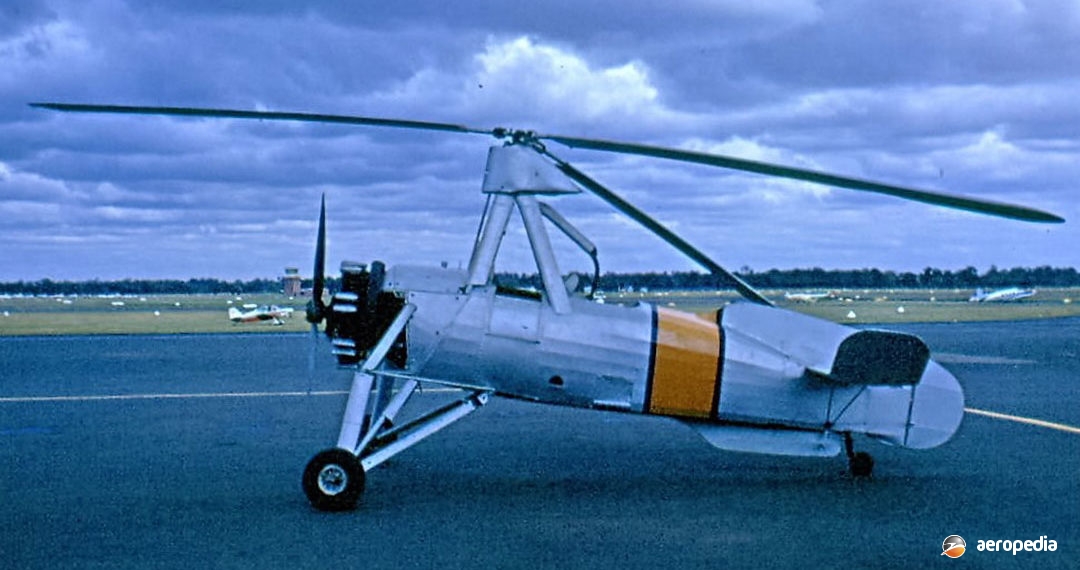Photograph:
Cierva C.30 VH-USQ (c/n 772) at Bankstown, NSW in September 1970 (David C Eyre)
Country of origin:
United Kingdom
Description:
Two-seat gyrocopter
Power Plant:
One 104 kw (140 hp) Armstrong Siddeley Genet Major 1A seven-cylinder air-cooled radial engine
Specifications:
- Rotor diameter: 11.28 m (37 ft)
- Fuselage length: 6.01 m (19 ft 8½ in)
- Height: 3.38 m (11 ft 1 in)
- Max speed: 177 km/h (110 mph)
- Cruising speed: 153 km/h (95 mph)
- Initial rate of climb: 213 m/min (700 ft/min)
- Range: 459 km (285 miles)
- Empty weight: 553 kg (1,220 lb)
- Loaded weight: 816 kg (1,800 lb)
History:
Following upon the success of the C.19 series, development continued. In 1932 the Pitcairn Autogyro Company in the United States developed a satisfactory method of starting the rotor with a clutch and engine-drive mechanism, and this system was incorporated in the Model C.19 Mk IV. One of these was brought to Australia and registered VH-USO (c/n 5153) for the Autogyro Corporation of Australia, Melbourne, VIC on 5 November 1934. However, it was damaged beyond repair in an attempted take-off on 15 June 1935.
Development continued through a variety of designs to the Model C.30. Cierva commissioned Avro to modify a Model C.19 Mk IV to single-seat configuration with a stub wing, ailerons, rudder and elevator, fitted with a tilting rotor head, a control column hanging from the rotor head permitting the pilot to tilt the rotor to fly in any direction. This aircraft G-ABXP (c/n 5159) became the Model C.19 Mk V.
National Flying Service Ltd in 1932 then built the first Model C.30 G-ACFI (c/n 1), seating two and having an 11.27 m (37 ft) diameter rotor. The fuselage was converted from a Model C.19 and it was first demonstrated to the public at Hanworth in Middlesex on 27 April 1933. This conversion was improved to the Model C.30P, the prototype G-ACKA (c/n AH1) being built by Airwork Ltd at Heston in Greater London, and had a 104 kw (140 hp) Genet Major 1A engine and folding rotor blades. Three more Model C.30Ps were built by A V Roe & Company Ltd at Manchester.
In 1934 A V Roe & Company acquired a licence to build the Model C.30 at Manchester with a wide-track parallel undercarriage and, as the Model C.30A, about 66 examples were built, with a further 25 being completed in France, and 40 in Germany. In his book ‘British Civil Aircraft (Vol 2)’ A J Jackson described the development of the autogyro. In 1933 a C.30 G-ACFI was “fitted with a special rotor head enabling a direct take-off without forward run. This was perfected as the Autodynamic Head, which allowed the rotor to be speeded up beyond its take-off revolutions with the blades at zero incidence and then suddenly to go into positive pitch, creating sufficient excess lift to leap some 6.1 m (20 ft) into the air”.
Following Ciervas death at Croydon in Greater London in the take-off crash of a KLM Douglas DC-2 PK-AHL on 9 December 1936, the development of Cierva autogyros ceased and the last model to be built was the C.40.
Most of the surviving Model C.30 aircraft were impressed by the RAF during World War II, operating with No 529 Squadron at Crazies Hill in Henley-on-Thames. A dozen survived to return to civil service later, being obtained by the Cierva Autogiro Company Ltd and were overhauled.
In more later years at least six have been rebuilt for museums, and examples are held by the RAF Museum at Hendon (K4234 / G-AHMJ); Shuttleworth Trust (K4239 / G-AIOC); Stockholm Technical Museum (SE-AEA); Dutch National Air Museum (SE-AFI); Science Museum, London (AP507 / G-ACWP); and in Buenos Aires in Argentina (LV-FBL).
Twelve were acquired by the RAF in 1934 for Army co-operation work (K4230 to K4239, K4296 which was fitted with floats, and K4775) becoming known as the Avro 671 Rota I. The first production C.30A G-ACUI (c/n 705) was delivered to the Marquis of Dufferin and Ava in 1935 and subsequently many were used privately in the United Kingdom. Many put on displays at National Aviation Days and in due course many were fitted with a canopy rather than having open cockpits. Largest operator of the type in the UK was the Autogiro Flying Club of Hanworth with six examples. Examples were exported to Holland, France, Germany, Switzerland, Poland and Italy. Two went to Tata Airlines of Bombay (VT-AFQ and VT-AFS), and one to Prince Ghanshyain Singhji (VT-AFF) in India.
Three Model C.30As were brought to Australia. VH-USQ (c/n 772 – ex G-ACXP) was imported and registered to W C Gatenby and H A de Kantzow of Roseville, NSW on 23 January 1935. On 20 June 1936 ownership was transferred to H A de Kantzow of Mudgee, NSW, the machine being withdrawn from service on 4 July 1940.
VH-UUQ (c/n 780 – ex G-ADCK) was imported and registered to Commonwealth Prospecting Ltd of Perth, WA on 2 July 1935. The registration lapsed twelve months later and its fate is not known.
VH-USR (c/n 792) was first registered to Andrew T Reid of Sydney, NSW on 14 June 1935. This machine was also known as an Avro 671. On 28 June 1935 it was withdrawn from service. This aircraft was stored at various locations over the years, particularly by the Royal Aero Club of NSW in its hangar at Bankstown, occasionally being placed on static display at aviation events at Bankstown. In 1979 it was presented to the NSW Museum of Applied Arts and Sciences but, as space was not available, it was displayed with other historic aircraft at Joe Drage’s museum at Wodonga, VIC, and later at Airworld, Wangaratta, VIC for a period. In 1999 the aircraft was returned to Sydney, restored by John Gallagher of Loftus in Sydney, and was placed on display at the PowerHouse Museum in Sydney.

